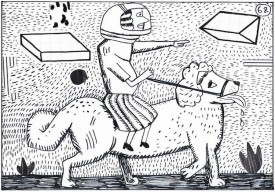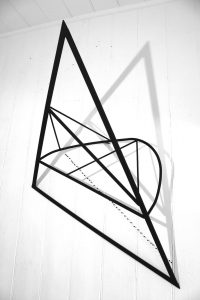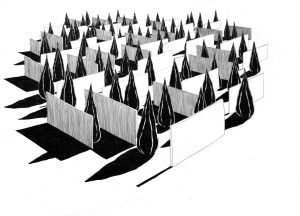23 April to 16 July 2016
To Draw is to be Human brings together the work of five artists that use drawing as the centre of their practice. Through their diverse artistic styles, these artists are investigating the key principles of narrative, construction, gesture, mapping and inscription in this exhibition.
Kate Black’s drawings illustrate an internal world depicting scenes from an invented, strange soap opera. This series of drawings reveal characters that come across the 4th Dimension, symbolized by odd geometric shapes suspended in the air, or encountered on the ground. The shapes transport the characters into uncanny and surreal worlds; they are portals into narratives that the artist likens to ‘Coronation Street on acid.’
Andy Black’s work involves constructing imaginary spaces from an index of motifs. He has drawings of roughly a hundred forms collected together in a small sketch book. Some of these forms are objects from the landscape – trees, bushes, rocks, mountains, lakes. Others are sharp-edged and geometric or more amorphous and blobby. The artist creates diagrams of how to organise the pictures (plot, island, field, glade, parterre) forming the syntax of an open-ended series of drawings.
Tracy Himsworth’s drawings record her findings from specific journeys she has plotted. These findings include her experiences and encounters with found objects which are then recreated through various drawing methods. The sketch map becomes a mental record of her movement through her immediate environment. She records this information through lines, using the joints and intersections of the marks to indicate which paths she has walked.
Lucy O’Donnell uses the concept of ‘wonder’ as a poetic mode of enquiry to explore how the grammar of syntax can be employed. Wonder is utilised in her drawings as a device to review the world. The work presented in To Draw is to be Human seeks to question how gestures are observed, read and subsequently understood by varying away from traditional drawing techniques; marking spaces with inscriptions, sounds and her body.
Through hand-drawn marks, Sally Taylor aims to understand more about human relationships, specifically her own interaction with others. She investigates formal concerns about communication, and recent work has developed into an investigation of the dynamics of social groups – particularly how hierarchies emerge, how roles are assumed and behaviours are managed.



